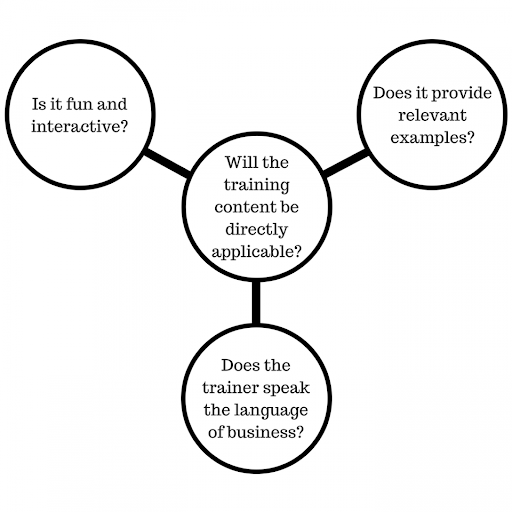May 30, 2018 / Esther Choy

Businesses have learned the many uses of storytelling. It draws customers, gives employees a sense of purpose and makes messages stick. So there’s a natural inclination for successful business leaders to want to build storytelling into the capabilities of our workforce. But who’s going to help the workforce build this skillset? Many companies turn to a business storytelling trainer. But many also worry about how this soft skill will translate into tangible results.
Selecting the right trainer will go a long way–so how do you make sure you find the person who will absolutely deliver the most value and give you the highest return on your investment?
Here are four questions to ask before committing your team’s time and your company’s money.
1. Does the trainer speak the language of business?
When hiring a trainer, some leaders look to people who can teach their team the basic tenets of storytelling. They may look to actors, improv comedians or storytellers (yes, it is a legit profession). We can all learn a great deal from those who make a living acting or telling their own stories on stage. Business storytelling, however, is more than stage performance, personal storytelling or open mics at your local pub. A business audience won’t find your team credible and compelling if they only tell stories from the heart and offer no value-add proposition.
Business storytelling requires seamlessly blending storytelling performance with an intimate understanding of the context in which the stories are told. For instance, the well-placed use of industry terms can change a story from irrelevant to immediately applicable. And translating those terms so the audience thinks about them in new ways can take the story from stale to riveting.
Good news. When interviewing potential trainers, you can give them a specific challenge your team faces and ask them to share concretely how their tools will help your team to overcome the challenge. Not only will you get a sense of how much the trainers understand your industry, you will also get a glimpse of the training methods used.
2. Will the training content be directly applicable?
After the training, the team should not be scratching their heads, thinking, “How do I apply this?”
When I was pursuing my MBA, students registered for classes using a “points” system. Every student was allotted a fixed amount of points. For especially popular courses, we had to show how much we wanted to take them by allocating as many points as we were willing to bid on them. During my second year in business school, I used more than half my points to get into a negotiation class with a very popular professor. I came to class excited and remained committed the entire semester. Unfortunately, I rarely use what I learned there. The negotiation training just didn’t work for my context and personality. Maybe someday I will sit down and think about how to translate it. But until I have that luxury, I am left wishing I knew how to directly apply what I’ve learned from the class to my life.
Similarly, a useful storytelling training needs to close the gap between what happens in the training session and what happens on the job. The trainer has to make it clear how the principles learned in the workshop are applicable to your industry and your team’s job functions. Nurses will face different communication challenges than actuaries, for instance— so be sure the trainer can make the training relevant to your niche.
Good news. You can test the training’s applicability in advance by looking for a trainer who offers templates and tools that are relevant for your context so the people on your team can use them the next time they need to translate data, give a presentation, lead a project meeting or meet with a client.
3. Does it provide relevant examples?
Seeing examples of how specific principles of storytelling can be used in your industry’s context will make your team confident to say, “Now I see how it’s done, so let me try.”
One key principle of storytelling, for instance, is to make the complex clear. Giving a training for the financial services sector, I might provide the example of financial advisor Joel Moore, whose story I’ve shared in my book Let the Story Do the Work. Moore guides his audience of non-professional investors through the thicket of complex financial products by grouping these products into two categories: Loaners vs. Owners. “Loaners,” he explains, includes peer-to-peer lending, mezzanine debt, bonds and other products. “Owners” refers to venture capital, private equity, stocks and so on. This simple grouping makes the complex clear, helping Moore’s audience get the gist of each type of product he wants to explain to them.
Good news. By nature, storytelling training must cover some of the basics. Plot, characters, beginning, middle and end—most people learned about these in elementary school. But simple things become brilliant when applied in a very specific or unexpected way–and that’s why examples turn these simple principles into vital learning experiences that even your most educated and astute team members can learn from.
4. Is it fun and interactive?
While it’s true that business storytelling is about more than the creativity of stage performances or personal storytelling, that doesn’t mean fun isn’t part of the equation. During a business storytelling training, your team should have lots of fun while doing serious things.
Storytelling connects people. Yes, even telling a story about dividend yields can connect people. The whole point of business storytelling is to engage an audience’s emotions on unexpected topics, connecting the listener and the teller. So fun and interaction are two natural byproducts of learning to tell stories–if the training leaves time for the attendees to practice stories of their own.
Good news. The main goal for engaging a trainer might be to improve your team’s communication skills. But if you hire a trainer who gives the team time for guided practice, you get even more than that. As your team tests out their stories, you should expect laughter and curiosity. This naturally leads to team bonding. So you are not only encouraging stronger communication skills, you’re also meeting the all-important goal of team building.
These are the criteria we meet and exceed in every training session. Contact us for business storytelling training!
This article originally appeared on Forbes.com.
Related Articles
How Leaders Use Storytelling To Inform And Influence
5 Quotes That Teach You Everything You Need To Know About Leadership Storytelling
#businessstorytellingtraining #corporatetraining #offsite #selectingtherighttrainer #trainingROI
Better Every Story
Leadership Transformation through Storytelling
"This is an amazing and insightful post! I hadn’t thought of that so you broadened my perspective. I always appreciate your insight!" - Dan B.
Get Esther Choy’s insights, best practices and examples of great storytelling to your inbox each month.




